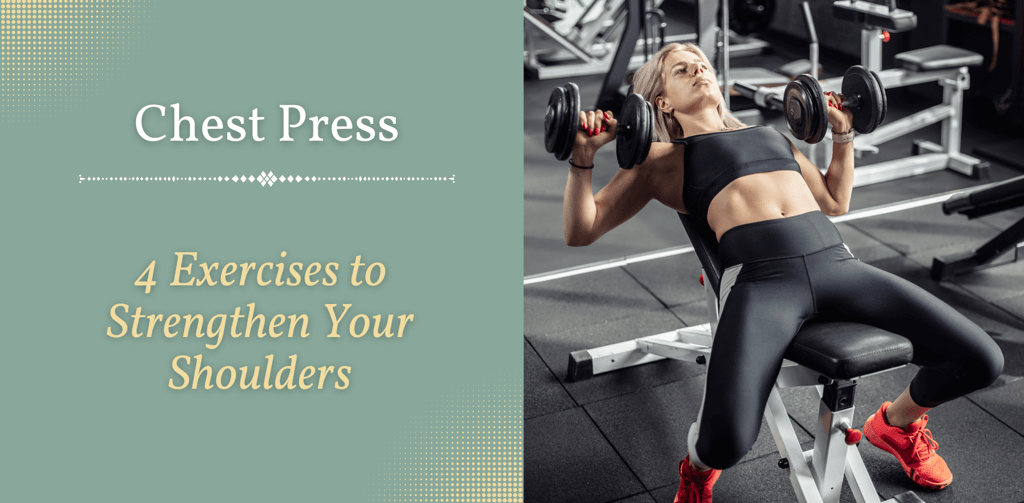Add your promotional text...
4 Chest Press Exercises To Help You Grow And Strengthen Up Your Shoulders
3/30/20237 min read


The chest press is an effective exercise for targeting the muscles of the chest, as well as the shoulders and triceps.
Here are a few different types of chest press exercises you can try:
1. Bench Press
2. Incline Bench Press
3. Floor Chest Press
4. Glute Bridges Chest Press
The intent behind the variations is that it works on the different parts of the chest. Also, some exercises, such as the floor press, is a good alternative if you don’t have a bench, but also want to focus on pushing strength without worrying about the extra stretch.
If you have any questions or need some assistance, feel free to submit a comment or send us a message here.
In Conclusion
Each variation targets the chest muscles and surrounding areas differently, and they all have their unique benefits. You can choose which of the variations suits you best. Although it’s essential to choose one that aligns with your fitness goals and abilities. It’s also crucial to use proper form and technique to avoid injury and maximize the effectiveness of the exercise.
All these chest press variations improve your upper body strength, stability, and endurance. They are a great addition to any workout routine, whether you’re a beginner or an experienced athlete.
1. Bench Press
The bench press is a compound exercise that primarily targets the muscles of the chest (pectoralis major and minor), the anterior deltoids (front of the shoulders) and triceps. It’s a popular exercise for building upper body strength and muscle mass.
Increases the challenge within creating muscle symmetry as you’re lifting both dumbbells simultaneously.
Muscles Worked: chest, anterior deltoids, triceps
Benefits of Bench Press
Increased upper body strength: By targeting multiple upper body muscles, it increases overall upper body strength, which can translate to better performance in other exercises and your daily activities.
Improved muscle size: Stimulates muscle growth, particularly in your chest, shoulders, and triceps, leading to a more toned and defined upper body.
Increased bone density: As a weight-bearing exercise, it helps to increase bone density, which is important for overall bone health and for reducing the risk of osteoporosis.
Improved posture: By strengthening your upper body muscles, it helps you to improve posture and reduces the risk of developing poor posture habits.
Increased metabolism: The intense nature of bench press can help increase metabolism, leading to increased calorie burn and potential weight loss.
Enhanced athletic performance: The strength and muscle gains from bench press translates to improved athletic performance, particularly in sports that require upper body strength, such as basketball, football, and swimming.
In addition to building strength and muscle, the bench press can also improve your muscular endurance, power, and overall fitness. It’s a highly effective exercise for developing pushing strength, which can be useful in many sports and activities.
However, it’s important to note that the bench press may not be suitable for everyone, especially for those with shoulder or chest injuries. It’s important to consult with a qualified fitness or medical professional before starting a new exercise program.
How to do it:
Lie down on a flat bench with your feet flat on the floor.
Grasp a barbell or dumbbells with an overhand grip, with your hands positioned slightly wider than shoulder-width apart.
Lift the bar or dumbbells off the rack and hold them above your chest, with your arms extended.
Lower the weight slowly towards your chest, keeping your elbows close to your sides and your shoulders down and back.
Stop when the bar or dumbbells are just above your chest, then press the weight back up to the starting position by extending your arms.
Perform 4 sets of 8 – 10 repetitions.
2. Incline Chest Press
Incline chest press is a variation of the chest press exercise where the bench is set at an incline, usually around 45 degrees. This exercise is great for targeting the upper portion of the chest muscles, also known as the clavicular head of the pectoralis major.
Muscles worked: upper chest, anterior and lateral deltoids, triceps
By performing incline chest press, you are putting more emphasis on the upper chest muscles, which helps to create a more defined and rounded chest appearance. This exercise also engages the shoulders and triceps to a lesser degree.
Benefits of Incline Chest Press
Builds upper chest muscles: targets the upper portion of the chest muscles, which is often difficult to isolate with other chest exercises. This helps to create a well-rounded, balanced chest.
Increases strength: A compound exercise that engages multiple muscle groups, making it an effective way to increase overall strength and power.
Improves posture: Strong chest muscles help to improve posture by pulling the shoulders back and opening up the chest, which can reduce the risk of back and neck pain.
Enhances athletic performance: The strength and power gained from doing incline chest press can translate to improved athletic performance, particularly in sports that require upper body strength and power, such as football, basketball, and tennis.
Provides variety: Offers a variation to traditional flat bench press and adds variety to your workout routine. This helps to prevent boredom and keeps your workouts challenging.
Even though the incline chest press works the same muscles as the bench chest press, this variation allows you to better target the upper chest muscles (more than the traditional bench chest press).
How to do it:
Adjust the bench: Set the bench at an angle of around 30-45 degrees. Lie down on the bench with your feet firmly planted on the ground.
Grip the bar: Grasp the bar with a slightly wider than shoulder-width grip. Your palms should be facing forward.
Unrack the bar: Unrack the bar and hold it above your chest with your arms fully extended. Your elbows should be slightly bent.
Lower the bar: Inhale and slowly lower the bar towards your upper chest. Keep your elbows at a 45-degree angle from your body.
Press the bar: Exhale and press the bar back up to the starting position. Keep your arms fully extended at the top of the movement.
Perform 4 sets of 8 – 10 repetitions.
4. Glute Bridge Chest Press
The glute bridge chest press is an exercise that combines the glute bridge and chest press movements into one exercise.
Works: Chest and glute muscles, but also targets front shoulders, triceps and abs.
Benefits of Glute Bridge Chest Press
Strengthens the glutes: The glute bridge portion of the exercise targets the glute muscles, helping to strengthen and tone them.
Builds upper body strength: The chest press portion of the exercise targets the chest, shoulders, and triceps, helping to build strength and muscle in the upper body.
Improves core stability: The glute bridge portion of the exercise also engages the core muscles, helping to improve core stability and strength.
Enhances overall fitness: A compound exercise that works multiple muscle groups at once, making it an efficient way to enhance overall fitness and physical conditioning.
TIPS
Make sure to keep your back flat on the bench, your feet firmly planted on the floor, and your core engaged throughout the movement.
Avoid bouncing the weight off your chest and using momentum to lift it back up.
3. Floor Chest Press
And a progression of the floor press is the glute bridge version, at which makes more challenging as you’re focusing on maintaining the glute bridge position whilst pressing; the glute bridge version works the legs as well (hamstrings and glutes)
Muscles worked: Primarily emphasis chest and triceps, but it also targets the anterior shoulder.
The floor chest press is a variation of the traditional chest press that is performed lying on the floor instead of on a bench.
Benefits of Floor Chest Press
Builds chest strength: The floor chest press targets the same muscles as the traditional chest press, including the pectoralis major and minor, the deltoids, and the triceps. By performing this exercise regularly, you can increase your chest strength and improve your overall upper body power.
Improves stability: Because it requires you to maintain your balance and stability while lying on the floor, it helps to improve your overall stability and core strength.
Reduces shoulder strain: Some people experience shoulder pain when performing traditional chest press exercises. The floor chest press can help alleviate this pain by reducing the strain on the shoulder joint.
Enhances muscle endurance: The floor chest press can be performed with lighter weights and higher reps, which can help improve your muscle endurance and cardiovascular fitness.
The Floor Chest Press it’s good for beginners because it places less strain on the shoulders and with the limited range of motions it allows you more focus on triceps, but also helps to prevent injuries.
How to do it:
TIPS:
Keep your core engaged and your back flat on the bench throughout the movement.
Make sure the bar is moving in a straight line above your chest.
Avoid bouncing the bar off your chest, and maintain control throughout the exercise.
Adjust the weight to a comfortable level that allows you to perform the exercise with proper form.
Lie down on your back on a flat surface with your knees bent and your feet flat on the floor.
Hold a pair of dumbbells above your chest with your arms extended and palms facing each other. Your elbows should be slightly bent.
Lower the dumbbells towards your chest by bending your elbows until your upper arms touch the floor. Keep your wrists straight and elbows close to your body.
Pause for a moment, then press the dumbbells back up to the starting position by extending your arms.
Perform 4 sets of 8 – 10 repetitions.
TIPS:
To focus on your triceps, keep your elbows near your torso. Flare your elbows out to switch the emphasis to your chest.
You can also perform this exercise with a single dumbbell, alternating arms as you go
TIP
This has the bonus of strengthening your glutes while you work your chest.
Using the shoulders as an anchor point to push into helps depress and centrate the shoulders and scapula.
How to do it:
Lie on your back on a mat with your knees bent and feet flat on the ground.
Hold a pair of dumbbells with an overhand grip and extend your arms straight up, so the weights are above your chest.
Engage your glutes and lift your hips up until your body forms a straight line from your knees to your shoulders. Keep your feet and shoulders on the ground.
From this position, lower the weights down to your chest, bending your elbows out to the sides.
Push the weights back up to the starting position, keeping your elbows slightly bent.
Lower your hips back down to the ground to complete one repetition.
Perform 4 sets of 8 – 10 repetitions.
TIP:
To make the exercise more challenging, you can lift one leg off the ground while performing the chest press.
NOTE:
It’s important to perform the exercise with proper form to avoid injury and maximize the benefits.
If you’re new to weightlifting or unsure of how to perform this exercise correctly, it’s always a good idea to work with a certified personal trainer who can provide guidance and feedback on your form.ngaged and your back flat on the ground throughout the exercise.
Exhale as you push the weights up, and inhale as you lower them down.
You can adjust the weight of the dumbbells according to your fitness level
